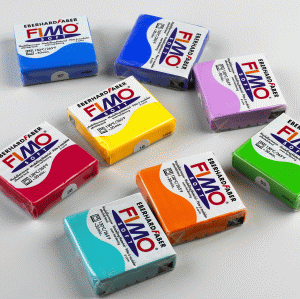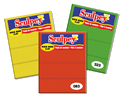
If FIMO is exposed to temperatures of more than 392 degrees F (= > 200 degrees C) hydrochloride gas can be developed. This gas is detectable by one's nose in very small amounts as even very small amounts cause an extremely stinging smell.
However, FIMO is intended to be baked
in ordinary kitchen ovens at 265 degrees F (= 130 degrees C). At that temperature
no "fumes" are developed. The smell which is noticeable during regular
baking at the temperatures indicated is the genuine FIMO aroma and is absolutely
harmless.
We also want to point out that:
* FIMO is tested by the Art and Craft
Materials Institute in Boston
* FIMO is authorized to carry the
AP-Seal "Non-toxic"
* no Health Labeling is required
for FIMO
* FIMO conforms to ASTM D-4236
In Germany, in the late 1930s, an enterprising woman named Fifi Rehbinder developed and marketed a clay product, which she called Fifi Mosaik, to use for doll heads. In 1964 she sold the formula to Eberhard Faber who developed it into the Fimo we know today.
At the same time, other manufacturers were making products similar to Fimo. Monica Resta of Italy used a form of the clay called LIMMO in Argentina in the late 1950s. It was also manufactured by a German company, but not Eberhard Faber. The manufacturer could have been Rudolf Reiser, who makes Formello and Modello, but there is no clear trail.
In those early days the clay was used for dolls, modeling and miniatures for doll houses. As it gained a wider audience, it was sold in toy stores. Pier Voulkos, for one, purchased Fimo from a toy store in Germany in 1970. Tory Hughes, who lived in Europe as a child, also discovered Fimo there, and Kathleen Dustin was introduced to Fimo while she was attending college overseas.
In the early 1970s, a family by the
name of Shaup, which had immigrated to the United States from Germany in
the 1950s, received a Christmas package from their grandmother. Inside
was a package of Fimo. Mrs. Shaup, immediately fascinated by the clay,
began making ornaments and figures, and soon people were asking her where
she got the clay. Her husband, out of work at the time, decided to import
Fimo, and in 1975, Accent Import began to import Fimo into the United States.
Mr. Shaup demonstrated the uses of the clay to various retail stores, and
sales began.

As the popularity of the clay grew,
other American companies, including Deeís Delights in the 1970s and the
American Art Clay Company (AMACO) in the 1980s, also began to import Fimo.
At the same time artists and American companies were discovering Fimo, an American company was developing its own version of the clay. A product called polyform has been developed in the 1960s for industrial purposes, but when itís industrial use didnít pan out, the clay was shelved. One day, a visitor to the plant played with a lump of the polyform and created a small figure. The figure was cured in a lab oven, and Sculpey/Polyform was born.
The white Polyform/Sculpey was actually sold on a small scale from 1967. By 1976, Mike Solos, the company founder, was marketing his product at craft shows and demonstrating its use to small retail shops. Colors weren't added to the clay until around 1984, and until then artists such as Sue Kelsey and her sister Cathy Johnson were coloring their clay with ground chalk and Tempera colors.
The popularity of polymer clay soon became evident, and AMACO, which manufactured natural clays for years, created their own polymer clay, Friendly Clay, in 1993, which they sold both in single color packets and pre-made canes. Accent Imports also began selling their own version of the pre-made cane: Kaleidocanes.
Another person interested in polymer clay, Marie Segal, had switched from creating objects out of bread dough to creating objects out of Fimo. Soon Segal and her husband were not only selling Fimo, but promoting it and offering excellent technical support to those who had discovered its charms.
Along the way, the Segals inadvertently became the developers and promoters of a brand new polymer clay product, Premo. In 1994, the Segals approached the Scupley/Polyform company with a question: why not have a high-quality American-made clay? Sculpey needed a little tweaking: more intense colors and a do-everything formula.

 Sculpey/Polyform
liked the idea, and the Segals began working on developing a better polymer
clay. Polymer clay artists in the Southern California area were fortunate
enough to be in on the development process, and many were given beta test
products. From these tests, the lastest addition to the polymer family,
Premo, was born. Look for more information on this product at te site
of Sculpey.
Sculpey/Polyform
liked the idea, and the Segals began working on developing a better polymer
clay. Polymer clay artists in the Southern California area were fortunate
enough to be in on the development process, and many were given beta test
products. From these tests, the lastest addition to the polymer family,
Premo, was born. Look for more information on this product at te site
of Sculpey.